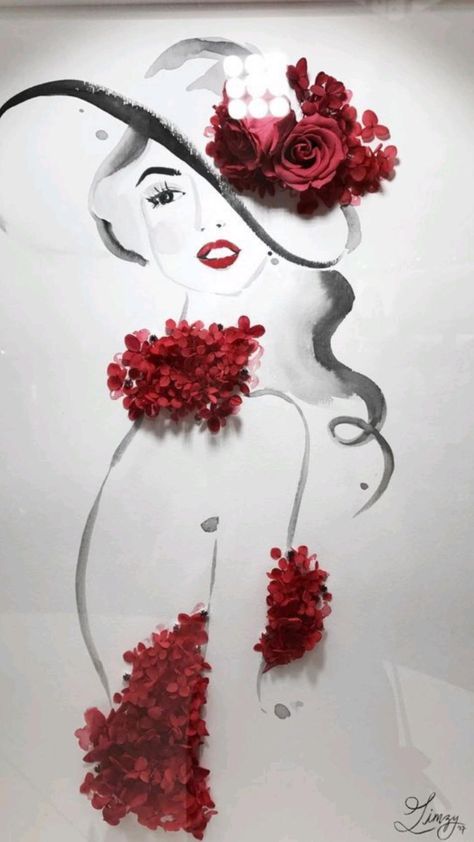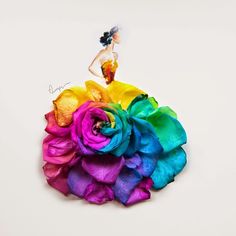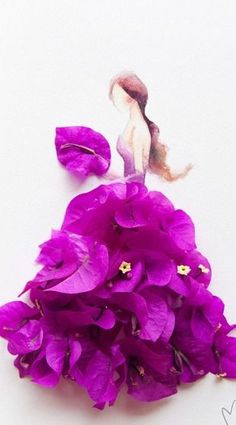3D Painting With Flower
3D painting with flowers in fashion design is a captivating technique that adds dimension, texture, and a touch of nature-inspired elegance to garments and accessories. This class note explores the art of 3D painting with flowers, including techniques, materials used, design considerations, historical context, contemporary applications, and practical insights for fashion designers looking to incorporate this unique approach into their work.

Historical Context
The use of floral motifs in fashion design dates back centuries, with flowers symbolizing beauty, femininity, and natural elegance. Historically, garments adorned with embroidered or appliquéd flowers were associated with luxury and craftsmanship. The evolution of techniques in textile art and fashion design has paved the way for innovative approaches like 3D painting, where flowers are rendered with lifelike depth and realism, creating wearable art pieces that blend tradition with modern aesthetics.
Materials and Tools
1. Fabric Paints:
- Fabric Acrylic Paints: Flexible and durable, suitable for creating 3D effects on fabric.
- Dimensional Fabric Paints: Designed specifically for adding texture and raised elements to painted designs.
2. Fabric Mediums and Additives:
- Puff Paint Medium: Mixed with acrylic paints to create a thicker consistency for raised textures.
- Textile Gel Medium: Provides structure and volume when mixed with paints for 3D effects.

3. Tools:
- Paint Brushes: Fine detail brushes for intricate work and larger brushes for base coats and blending.
- Palette Knives: Used for applying thick paint and creating sculptural effects.
- Sponges and Foam Brushes: Provide texture and blend colors seamlessly.
Techniques of 3D Painting with Flowers
1. Layering and Building Texture:
- Base Layer: Apply a base coat of fabric paint onto the fabric surface.
- Building Layers: Gradually build up layers of paint to create depth and dimension, allowing each layer to dry before adding the next.
2. Creating Petals and Floral Elements:
- Petals: Use a palette knife or brush to shape petals, focusing on realistic shapes and contours.
- Stamens and Centers: Add details like stamens and flower centers with fine brushes or dimensional paints.
3. Texturing Techniques:
- Dry Brushing: Lightly brush paint over raised areas to enhance texture and highlight details.
- Dotting and Dabbing: Use stippling techniques with a brush or sponge to create textured surfaces resembling pollen or flower veins.
4. Adding Dimensional Details:
- Dimensional Paints: Apply directly from the tube to create raised areas such as flower buds or intricate floral patterns.
- Mixing Mediums: Experiment with different textures by mixing fabric medium with paints to achieve varied effects.
Design Considerations

1. Color Selection: Choose colors that reflect the natural hues of flowers or create contrasting effects for visual impact.
2. Composition and Placement: Plan the arrangement of flowers on the garment or accessory to achieve balance and harmony.
3. Scale and Proportion: Consider the size of flowers relative to the garment or accessory to ensure they complement rather than overwhelm the design.
4. Fabric Choice: Select fabrics that allow for adherence of paints and dimensional elements, such as cotton, silk, or blends with a smooth texture.
Applications in Fashion Design
1. Couture and High Fashion:
- Evening Gowns: Embellish with 3D painted flowers for a dramatic and luxurious effect.
- Bridal Wear: Create intricate floral patterns on wedding dresses and veils, adding a personalized touch.
2. Ready-to-Wear and Accessories:
- Blouses and Skirts: Enhance everyday wear with subtle floral accents or bold statement pieces.
- Bags and Shoes: Adorn accessories with painted flowers for a unique and fashionable appeal.
3. Collaborative Projects:
- Fashion Collaborations: Partner with floral artists or designers to create limited-edition collections merging floral artistry with fashion.
Contemporary Trends and Innovations
In contemporary fashion, 3D painting with flowers continues to evolve with technological advancements and creative collaborations:
1. Mixed Media Integration: Combine 3D floral painting with embroidery, beadwork, or digital prints for multi-dimensional effects.
2. Sustainable Practices: Explore eco-friendly paints and recycled materials for creating environmentally conscious designs.
3. Digital Design Tools: Use digital software for designing and planning intricate floral patterns before transferring them onto fabric.
Conclusion

3D painting with flowers in fashion design offers designers a unique opportunity to blend artistry with wearable fashion, creating garments and accessories that are both visually stunning and emotionally evocative. By mastering techniques, understanding design principles, and embracing innovation, designers can leverage this technique to craft pieces that resonate with nature’s beauty and the individuality of their clientele. As the fashion industry continues to embrace creativity and sustainability, 3D painting with flowers remains a timeless and captivating medium for expressing artistic vision and pushing the boundaries of textile art in fashion.
